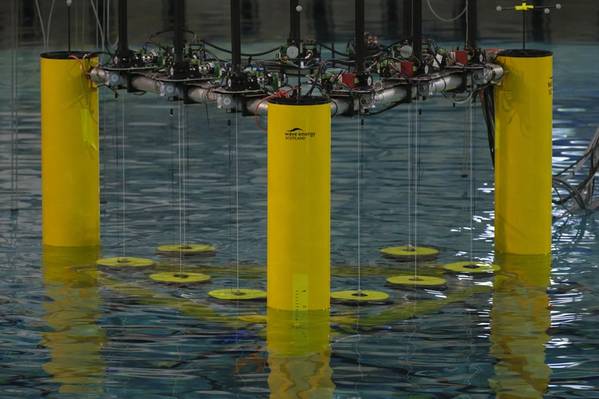
Wave Energy Scotland (WES), a subsidiary of Highlands and Islands Enterprise (HIE), is running tests at the University of Edinburgh’s FloWave facility, to determine the potential for floating platforms that can be used by both offshore wind and wave energy devices.
The move has been prompted by a report by Offshore Wind Consultants (OWC) exploring the synergies between the two areas of renewable energy and the potential benefits of sharing infrastructure, services, and supply chains.
According to HIE, conditions in the testing facility have been created to match one of the west of Scotland offshore sites recently leased through the Scotwind program that also has wave energy potential.
The testing incorporates multiple identical wave energy absorbers mounted onto a semi-submerged, triangular floating platform.
The absorbers are based on AWS Ocean Energy’s Archimedes Waveswing; a submerged wave power buoy developed and funded through WES’s Novel Wave Energy Converter Programme. The platform is similar to many concepts under development within the floating wind sector, HIE said.
"The outcomes of the tests will improve the understanding of the performance and physical interaction between multiple wave absorbers on a floating platform," HIE said.
Results are expected to show whether it is feasible for offshore wind and wave energy projects to share infrastructure in the form of versatile wind and wave platforms, which could improve efficiency and reduce costs.
Dr Thomas Davey, principal experimental officer at the University of Edinburgh FloWave facility, said: "WES, through its technology development programme, has been working with FloWave and the University of Edinburgh since its inception to develop the requirements for robust testing campaigns. It’s great to see a focus now on an ambitious new approach as they complete their own tank testing to inform the future development path of versatile platform designs.”
Elva Bannon, research and engineering manager with WES, said: "Recent reports, and support from Scottish Government, show the vast opportunity for collaboration and cross-over between floating wind and wave energy. We are taking the initiative to carry out research in the area by completing a testing campaign to progress the sector’s understanding of how these versatile platforms may perform, which can help reinforce the economic analysis. We are excited to share further results of this project over the coming months.”



